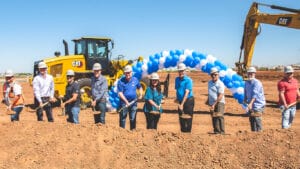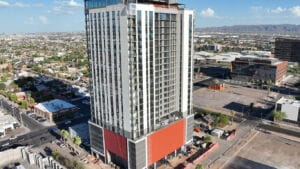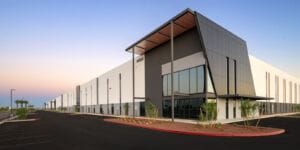By Kelly Corsette,Communications and Public Affairs Director, City of Scottsdale
When Cox Communications scoured locations for its next generation high-speed Internet service, it sought a smart, hip, tech-savvy customer base.
It selected a luxury apartment development rising immediately east of SkySong, the ASU Scottsdale Innovation Center – in the heart of Scottsdale’s McDowell Corridor.
The city council made revitalization of the McDowell Corridor and southern Scottsdale a key priority during recent strategic planning sessions, and the Cox announcement is another significant signpost on its road to recovery.
 That road is getting much busier, with many more projects planned, underway or recently completed.
That road is getting much busier, with many more projects planned, underway or recently completed.
“Things are moving in the right direction, no doubt,” said Scottsdale Mayor W.J. “Jim” Lane. “We put the component elements in place, and we are seeing results in the form of more activity and investment.”
Highs and lows on McDowell Road
Through the past four decades, McDowell Road in Scottsdale has witnessed the highs and lows of growth, recession and renewal as the regional economy boomed, then busted and is now slowly but steadily recovering.
When the “McDowell Motor Mile” was home to auto dealers from every major brand, it accounted for the lion’s share of city retail sales taxes. The intersection at Scottsdale and McDowell roads was one of the busiest in the entire Valley – until the freeways opened.
Los Arcos was the Valley’s first indoor mall and another major economic engine for the city, but the mall struggled as newer centers with more stores and better amenities opened. By 2000, the mall was closed and soon after, the ground stood empty, much like it had in 1969 just before the mall went up.
After discussions to build a hockey arena for the Phoenix Coyotes fell through, officials with both the city and Arizona State University saw an opportunity for something special in the strategically located McDowell Corridor – a place where academics and tech startups could merge, grow and create a new chapter for the Scottsdale economy.
City council member Virginia Korte has seen all that and more during her long career in business and community work in Scottsdale.
“My family has been vested on McDowell for more than 40 years,” says Korte. “I have witnessed the rise and fall of the McDowell corridor, and I believe it will rise again.”
SkySong takes flight
Nearly 10 years ago, the City of Scottsdale and the Arizona State University Foundation reached an agreement to redevelop the corner of Scottsdale and McDowell roads into what would become SkySong – a 42-acre development that enjoys a unique relationship with Arizona State University.
The city invested more than $80 million to help build SkySong.
In addition to locating its own innovation units at the center, ASU provides tenant companies with direct access to relevant research, educational opportunities and cultural events on its campuses.
For several years after SkySong opened its doors in 2008, the project was an island, as much of the surrounding property remained vacant lots and empty properties.
But the landscape at SkySong has evolved quickly in the past two years, with additional office buildings (290,000 square feet) under construction, and tenants moving in to the new the SkySong apartments on the site. The project’s first retail component, more than 10,000 square feet of stores and restaurants, was announced in May.
Residential revival
Next door to SkySong, luxury apartments called “San Travesia” will welcome residents by the end of the year. These will be among the first in the nation to offer Cox’s new gigabit Internet service, which seems a perfect fit for the young professionals working at SkySong and elsewhere in the many software and technology companies that call Scottsdale home.
Further west, an old car dealership is being re-cast as modern urban residential. “Las Aguas” will include more than 150 apartments, with walk-up access right from the McDowell sidewalk, as well as 18 “carriage house” units built atop garages. Most residents will park in the two-story structure remaining from the previous auto dealership.
“With residential in place, the retail will return,” says Korte. “McDowell will re-establish an identity, a real sense of place as a destination with everything people want.”
Creative re-use
Nearby, designer Jeff Berghoff has taken another defunct dealership and turned it into the headquarters for his landscape design, installation and maintenance company.
Berghoff is on the board of the Scottsdale Gateway Alliance, a new private group focused on southern Scottsdale and the McDowell Road Corridor. His story is an example of the new, creative thinkers who are pushing McDowell beyond its historic reliance on auto dealers.
“It hit me that I have a growing business, and I have a lot of employees,” Berghoff says in a video on the Gateway Alliance website, “and this would be a really great space to move my business.”
Upgrading infrastructure
Cox’s decision to launch its latest technology on McDowell shows the high priority that businesses and people place on modern infrastructure. Earlier this year, Google identified Scottsdale (along with Phoenix and Tempe) as a potential target community for Google Fiber, its ultra high-speed Internet product.
Google is evaluating a checklist and information provided by the city, and later this year should announce whether they will bring the product to Scottsdale.
“When you have this much interest from technology giants like Cox and Google that tells me that Scottsdale is in a great position for the future,” says Mayor Lane.
Since 2007, the private sector has invested about $400 million in the McDowell Corridor. The city is upgrading its infrastructure as well.
• See a map of private investment on the McDowell Corridor (pdf/1.5mb)
A $2 million project will widen the McDowell Road bridge over the Indian Bend Wash Greenbelt to add bike lanes and a protected pedestrian path, allowing people to directly access the parks and amenities in the greenbelt. Construction should begin late summer 2014 and take about one year.
The city also will widen the sidewalk on the north side of McDowell between Scottsdale and Miller roads to meet accessibility standards and, where possible, separate it from the curb to improve pedestrian safety. Construction should begin late in 2014 or early in 2015.
Beyond asphalt and concrete, the city will invest nearly $450,000 in transit money to increase the frequency of bus service on McDowell and Thomas roads, and add a SkySong stop to a route that includes the Phoenix Zoo and Desert Botanical Garden.
What’s next on McDowell?
Scottsdale’s McDowell Corridor shows how cities evolve, how neighborhoods and business districts are created, change and re-emerge. City leaders expect that story to be a strong one in the coming years, for one factor has remained constant.
The McDowell Corridor has and continues to be a lynchpin, a crossroads that connects unique and economically significant Valley landmarks to one another.
To the south, more than 60,000 students attend classes at Arizona State University. To the north, Downtown Scottsdale has emerged as one of the most diverse and dynamic city centers in the state. Papago Park’s stunning rock formations and cultural attractions rise to the east and to the west, the Loop 101 Freeway provides a strategic transportation link.
Connecting it all is the McDowell corridor, steeped in history and reinvigorated by millions of dollars in public and private investment.
“I can’t help but feel optimistic about McDowell,” says Korte, “because all I see is positive stuff happening.”




